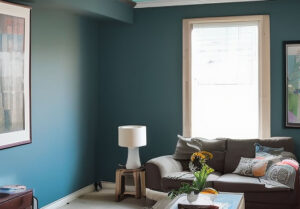How Interior Painting Can Transform Your Home
Interior Painters Perth can transform the look and feel of a home. It also protects walls from damage and wear.
There are many trends when it comes to interior painting. Strie is one such trend that allows for a unique look while blending with other aesthetics.

Interior painting is a decorative art form used to make a space more pleasant, appealing and comfortable. It is applied to walls, ceilings and trim. The process can include stencils, murals and patterns. It can also involve woodwork such as moldings. It is a common feature in residential and commercial buildings.
The preparation process is essential for any successful interior painting job. Without it, the finished product will not look as professional or sharp. The prep process consists of several important steps, such as cleaning, making repairs, sanding, priming, caulking seams and more. Performing these tasks properly can ensure that the final result looks good and lasts for a long time.
Before beginning any paint project, it is vital to thoroughly clean the surfaces to be painted. This step will remove any dust, dirt, grime or other debris that may interfere with the outcome of the paint job. It is a good idea to use water and detergent for this purpose. It is also a good idea to vacuum and sweep the space prior to starting.
During the pre-painting phase, it is a good idea to move or cover any furniture in the room. This will help prevent any damage that might be done to the furniture during the painting process. It is also a good idea to cover any electrical outlets and light switches with plastic covers. This will prevent children and pets from accidentally knocking over the covers or getting paint on themselves.
Another key aspect of the pre-painting phase is repairing any cracks or holes in the walls and ceilings. This is important because it will help to ensure that the new paint adheres to the surface properly. It is also a good idea to repair any loose or peeling areas of the wallpaper as well.
The final step in the preparation process is to double-check the color of the paint that is being used. This is a simple and effective way to ensure that all the ingredients are mixed properly and that the shade matches exactly what was intended for the room.
Choosing the right paint color is one of the biggest decisions you’ll make for your home. It’s a commitment, and it will affect the mood, function and style of your space. That’s why it’s a good idea to test swatches on your walls before committing to a color.
Ideally, you’ll be able to do this in a room that is already furnished and decorated. If you can’t do this, you’ll need to test swatches in a similar space with different lighting. It’s a good idea to move the swatches around over a few days to see how they look in different directions of light, too. Taking your time with this process will save you a lot of frustration and money in the long run!
If you’re looking for inspiration, consider starting with a piece of furniture. Pick up throw pillows, blankets or table linens in colors that catch your eye, and use them as a guide for the rest of your color scheme. If you’re not sure how to select a color, consider using a color wheel. Contrasting colors (opposite each other on the wheel) energize and enliven each other, whereas neutrals or harmonious colors (adjacent on the wheel) are aesthetically pleasing.
When choosing paint colors, you also want to keep in mind their undertones. For example, a simple beige may have yellow or green undertones, which will impact the way it looks on your walls. This is why it’s important to sample your paint — you may be surprised by the results!
It’s also a good idea to think about the reason you’re painting. If you’re planning to sell your home, consider sticking with a neutral shade that will appeal to a wide range of buyers. But if you’re not concerned with resale, don’t be afraid to choose bolder shades that will add personality and flair to your space! Just be sure to balance them with lighter trim and furniture shades to avoid a too-busy effect. If you’re still unsure, ask your paint specialist to create a custom blend that will be sure to please!
Painting is a time-consuming project that requires a high level of skill and attention to detail. Whether you’re looking to update the color of your living room or create a new look in your kitchen, a fresh coat of paint can make all the difference. In addition to enhancing the appearance of your home, a new coat of paint can also help hide stains and dirt.
Before beginning the painting process, it is important to prepare the surface for painting. This can include sanding the wall, cleaning the area and applying a primer. Primer helps the new paint to adhere to the surface and prevents it from peeling or chipping over time. It is also important to use low-VOC paint when painting the interior of your home. This type of paint reduces the amount of harmful chemicals that are released into the air and can improve indoor air quality.
If you are planning on selling your home in the future, a fresh coat of paint can make it more attractive to potential buyers. It will also ensure that your home is up-to-date and well-maintained, which can help you get a higher sale price.
It is important to remove as much furniture and other items from the room as possible before beginning the painting process. This will allow you to move around the room more easily and prevent accidental paint splatters on objects that you would like to keep intact. If there are items that you cannot move, be sure to cover them with plastic or painters’ tape to protect them from paint splatters.
Once the walls and trim are prepared for painting, it is time to begin the actual painting process. It is important to work in small sections, and to apply a thin layer of paint at a time. This will help prevent the walls from becoming too saturated with paint, which can cause them to become brittle or contaminated with mold and mildew.
It is also important to remember that it can take several coats of paint to achieve a fully saturated and even finish. If you are having trouble achieving the look that you want, it is a good idea to consult a professional painter who can advise you on what types of finishes and techniques will be best for your home.
A fresh coat of paint can make all the difference in the appearance of a room. It also serves a functional purpose, keeping materials like plaster and drywall from absorbing moisture and degrading over time. This can lead to structural damage, as well as potential contamination by pathogens like mold and mildew. In addition, the use of interior paint can help prevent dust, dirt, and other debris from gathering in a home or business.
A successful painting job requires a number of skills and techniques, including preparation, color selection, and application. Professional house painters are trained to perform these tasks in a safe and efficient manner, allowing them to complete projects more quickly and accurately than the average homeowner.
Interior painting is an inexpensive way to give your home or business a facelift and improve its overall look and feel. This is especially true if you live in an older home that hasn’t been painted in some time. In some cases, a fresh coat of paint can even increase the value of your property.
If you have a little extra time on your hands, you can save yourself some money by tackling the task yourself. However, painting an entire room is a significant project that can be overwhelming for people with limited experience. It’s important to take the time to choose the right supplies, prep the area, and practice the proper techniques in order to get a professional-quality finish.
There are a number of different interior paints on the market, and each has its own unique benefits. Water-based interior paints, for example, generally have lower VOC levels than oil-based varieties. Additionally, many water-based paints are odorless and don’t require any special ventilation. This makes them an ideal choice for people who have sensitive respiratory conditions or young children.
In this video, professional painter Frank Sinicrope explains the different components of interior painting and tips for getting a smooth and even coat. He also discusses the importance of patching cracks and holes, using the right type of brush, and preparing surfaces properly before painting.






